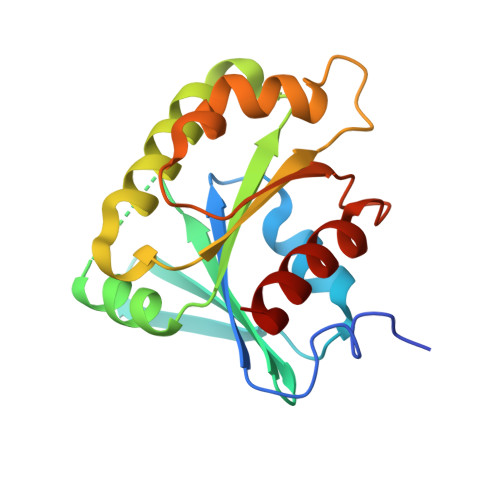Point mutations in Arf1 reveal cooperative effects of the N-terminal extension and myristate for GTPase-activating protein catalytic activity.
Rosenberg Jr., E.M., Jian, X., Soubias, O., Jackson, R.A., Gladu, E., Andersen, E., Esser, L., Sodt, A.J., Xia, D., Byrd, R.A., Randazzo, P.A.(2024) PLoS One 19: e0295103-e0295103
- PubMed: 38574162
- DOI: https://doi.org/10.1371/journal.pone.0295103
- Primary Citation of Related Structures:
8SDW - PubMed Abstract:
The ADP-ribosylation factors (Arfs) constitute a family of small GTPases within the Ras superfamily, with a distinguishing structural feature of a hypervariable N-terminal extension of the G domain modified with myristate. Arf proteins, including Arf1, have roles in membrane trafficking and cytoskeletal dynamics. While screening for Arf1:small molecule co-crystals, we serendipitously solved the crystal structure of the non-myristoylated engineered mutation [L8K]Arf1 in complex with a GDP analogue. Like wild-type (WT) non-myristoylated Arf1•GDP, we observed that [L8K]Arf1 exhibited an N-terminal helix that occludes the hydrophobic cavity that is occupied by the myristoyl group in the GDP-bound state of the native protein. However, the helices were offset from one another due to the L8K mutation, with a significant change in position of the hinge region connecting the N-terminus to the G domain. Hypothesizing that the observed effects on behavior of the N-terminus affects interaction with regulatory proteins, we mutated two hydrophobic residues to examine the role of the N-terminal extension for interaction with guanine nucleotide exchange factors (GEFs) and GTPase Activating Proteins (GAPs. Different than previous studies, all mutations were examined in the context of myristoylated Arf. Mutations had little or no effect on spontaneous or GEF-catalyzed guanine nucleotide exchange but did affect interaction with GAPs. [F13A]myrArf1 was less than 1/2500, 1/1500, and 1/200 efficient as substrate for the GAPs ASAP1, ARAP1 and AGAP1; however, [L8A/F13A]myrArf1 was similar to WT myrArf1. Using molecular dynamics simulations, the effect of the mutations on forming alpha helices adjacent to a membrane surface was examined, yet no differences were detected. The results indicate that lipid modifications of GTPases and consequent anchoring to a membrane influences protein function beyond simple membrane localization. Hypothetical mechanisms are discussed.
Organizational Affiliation:
Laboratory of Cellular and Molecular Biology, Center for Cancer Research, National Cancer Institute, Bethesda, MD, United States of America.
















